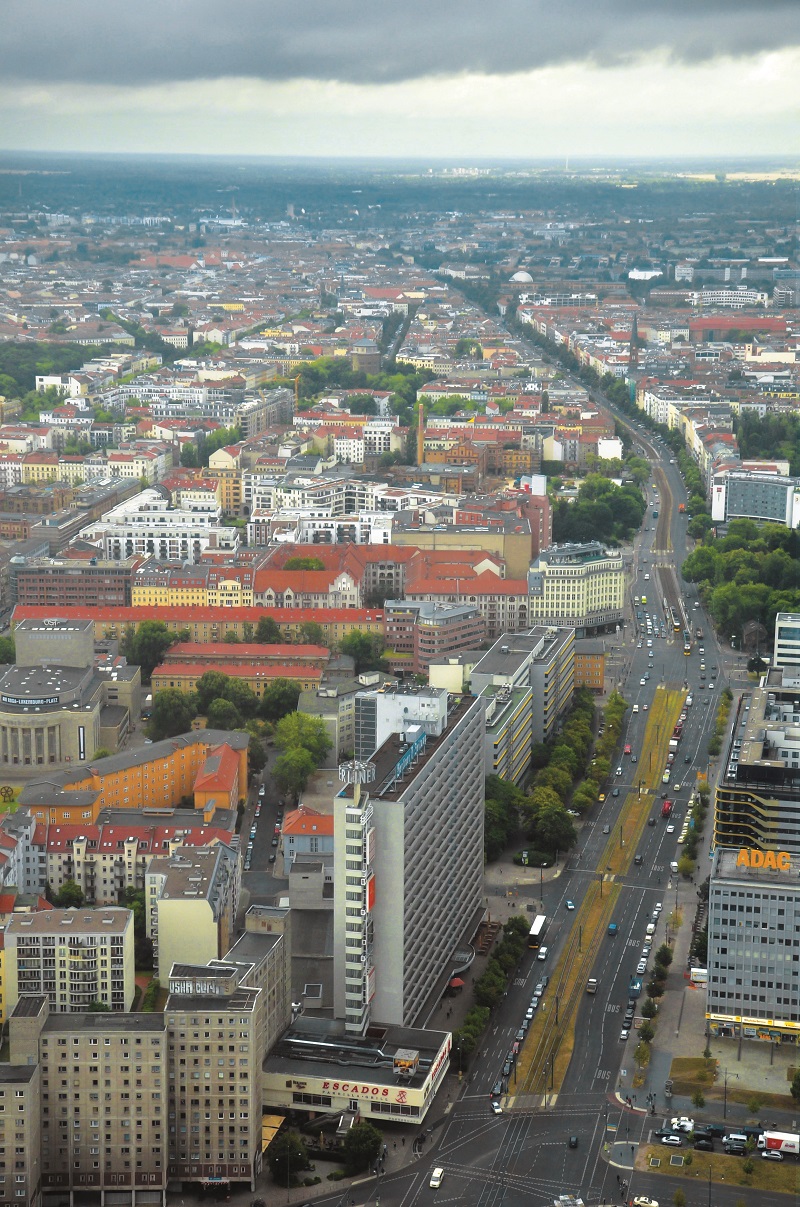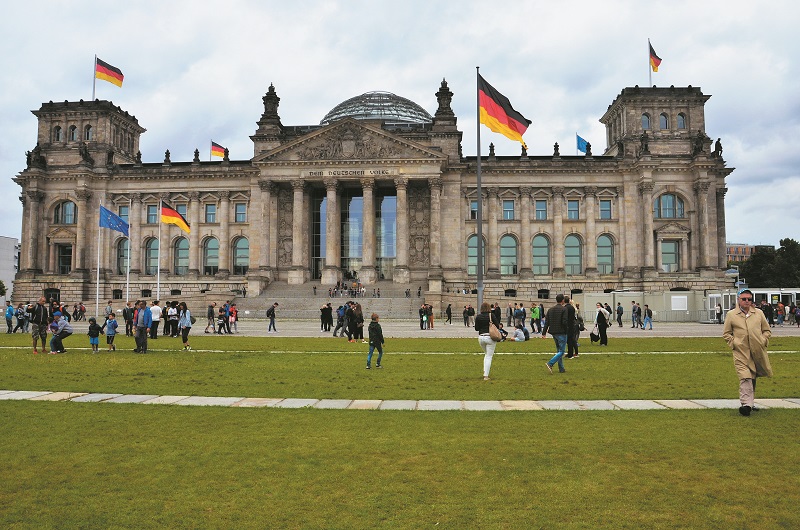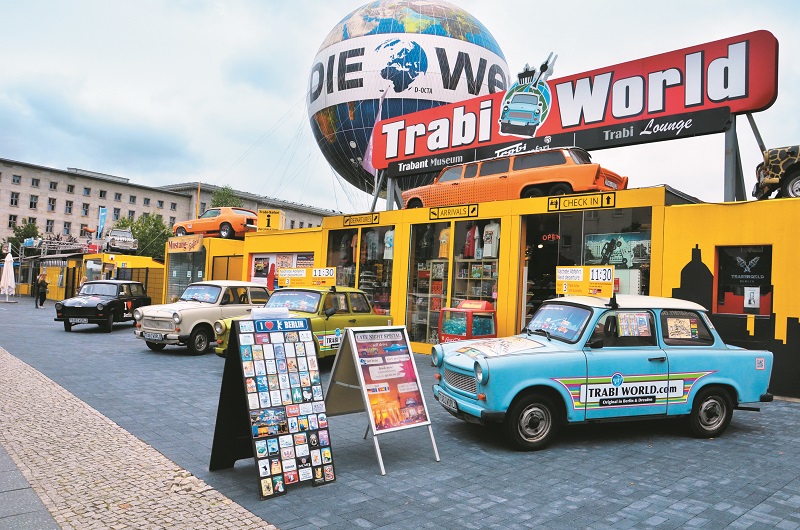
When it was completed, the tower revealed a major embarrassment for the GDR. Its major feature is a large orb and when the sun shines on its tiled stainless steel surface, the reflection usually appears in the form of a cross. Citizens referred to it as “The Pope’s Revenge” against the atheistic government, which sought to deflect the fiasco by declaring it a “plus” sign for the government.
The lifts — secretly procured from the West — whisk visitors up to the viewing deck in the orb, some 200m above ground. From here, there is a 360° view of Berlin, and its history is writ large.

Towards the East, the cityscape of GDR-era buildings is less crowded. During the final days of WW2, Berlin was defended by some 70,000 troops against an invading Soviet force many times larger. As the German troops retreated, they carried out Hitler’s “scorched earth” order not to let any German city fall into enemy hands except as rubble. The Eastern sector bears this out, as this was the route taken by the invading Soviet forces.
An empty field in the far distance is another historic landmark. After the fall of Nazi Germany, Berlin was divided into French, English, American and Soviet sectors, the first three of which quickly merged to become West Berlin. It was completely surrounded by the Russians. The Soviet leader Joseph Stalin attempted to starve West Berlin into surrender by a blockade, which was foiled by the Berlin airlift, with Allied forces flying supplies into the besieged city, and finally forcing the Soviets to lift the blockade — one of the first major crises of the Cold War in the wake of WW2. The empty field is the original airfield used for the Berlin airlift.
A large, dark patch of greenery is the Tiergarten, a city park that was a hunting ground for royalty. Nearby is the Brandenburg Gate, where US President Ronald Reagan made the 1987 exhortation, “Mr Gorbachev, tear down this wall!” Less than 1½ years later, the unthinkable happened: the Berlin Wall fell, and the Brandenburg Gate became a symbol of the reunification of Germany.

A more modern piece of kitsch is a few steps away from the Brandenburg Gate. This is the Adlon Hotel, once one of the swankiest hotels in Europe, hosting movie stars, royalty and politicians. It was from a balcony of the penthouse that royalty of a different kind, Michael Jackson, dangled his nine-month old child in 2002, to the cheers and screams of fans in the square below, and condemnation in the world’s media. The current Hotel Adlon Kempinski is a new building. Ironically, the original hotel survived the bombardment of Berlin in WW2 almost intact, only for it to be destroyed in a fire started by celebrating drunken Soviet soldiers in 1945.
Less than 1½ years later, the unthinkable happened: the Berlin Wall fell, and the Brandenburg Gate became a symbol of the reunification of Germany.
Once off limits, today you can walk through the Brandenburg Gate, passing from the former East Berlin to the former West Berlin and head towards the Reichstag, the building where parliament, the Bundestag, convenes. A fire in the building in 1933 triggered the Nazi party to declare a state of emergency and to emerge as the dominant force in German politics, headed by its chancellor, Adolf Hitler.
On the far side of the Brandenburg Gate is the tragic consequence of Hitler’s rise to power and the madness of the years that followed. It is the Holocaust Memorial, a monument to the murdered Jews of Europe. Built in 2003 on almost five acres, it is a mute, experiential museum that speaks to each visitor. It comprises grey stone blocks or stelae, and as the visitor descends the gentle slope deeper into the museum, the blocks grow in size, until the visitor is surrounded by towering blocks in every direction. Although it has no official meaning, many visitors find the experience disorienting, disquieting and even depressing — for the symbolism of walking deeper and deeper into a cemetery of rising tombstones is unmistakable.
The events of that period are never very far away. A short walk from the memorial is an unmarked patch of grass, surrounded by buildings. It is not even worth a second glance, unless you know this is the site of Hitler’s bunker, where in the dying days of the war, as the Soviets closed in, Hitler bit down on a cyanide vial and shot himself. His new bride, the ex-Eva Braun, consumed cyanide as well. Although the bodies were set on fire within a matter of weeks of conquest, the Russians had conclusive proof of Hitler’s death, thanks to his dental records. The West was kept guessing, as the Russians felt they were under no obligation to share the discovery. This resulted in decades of conspiracy theories — that Hitler escaped to a hidden refuge in South America, Antarctica and so on.

As you walk from the Brandenburg Gate and the Reichstag building, look at the line of stones embedded in the ground. The line continues across the road for some 150km — tracing the path of the Berlin Wall. There are still remnants of the wall in a few places, one of the best known being the East Side Gallery.
In 1990, artists were invited to paint on this 1.3 km-long section, and the best known of the many wall paintings is officially called My God, Help Me to Survive This Deadly Love, although it is informally called the Fraternal Kiss, or the Socialist Brothers. It depicts Leonid Brezhnev and Erich Honecker, the leaders of the Soviet Union and East Germany respectively, locked in a passionate kiss.
Another section of the Wall in central Berlin has been hacked to its rusted metal bars by souvenir hunters. This section fronts a museum called “Topography of Terror”, which recounts in dispassionate, chilling detail the rule of Nazi Germany in the years leading up to, and including WW2. The museum is located on the site of the former headquarters of the Gestapo and the SS, where prisoners of the Gestapo were tortured and executed in the cellar. School groups, tourists and visitors pause at the black-and-white photographs, maps and commentaries on the machine of destruction and death unleashed by the Nazis.
Further up the road is a more recent piece of history. This is Checkpoint Charlie, the best known of several border crossings before the reunification. Featuring in many movies of the era, the current-day Checkpoint Charlie is a private enterprise, with “soldiers” in American military uniform outside a “guardhouse”, ready to post with tourists for a fee.
Needless to say, Checkpoint Charlie is a tourist attraction, with cafés, restaurants and souvenir shops surrounding it. There are attractions dedicated to the Trabant, the much-maligned car that came to symbolise the GDR. It was slow, outdated and ugly, but the waiting lines were so long for the Trabant in East Germany that it is said that a father would put a deposit on one when his son was born, as it would only be delivered when the son was old enough to drive. Today, brightly-coloured Trabants are available for rent, so tourists can see Berlin from the discomfort of one.
Berlin is a modern, vibrant city and it is easy to enjoy without the baggage of its legacy but to make light of it would be doing the city and its history an injustice. Almost any old building from the early 20th century bears the scars of war — bullet holes, shrapnel damage or a repaired section — for the fighting was fierce. Much of the city was destroyed, so much so that a small hill, visible from the TV Tower, is an artificial one constructed from the rubble of the destruction. Even today, construction crews often come across unexploded ordnance from WW2.
Berlin wears its legacy well, having reconciled itself with the past while looking to the future.


